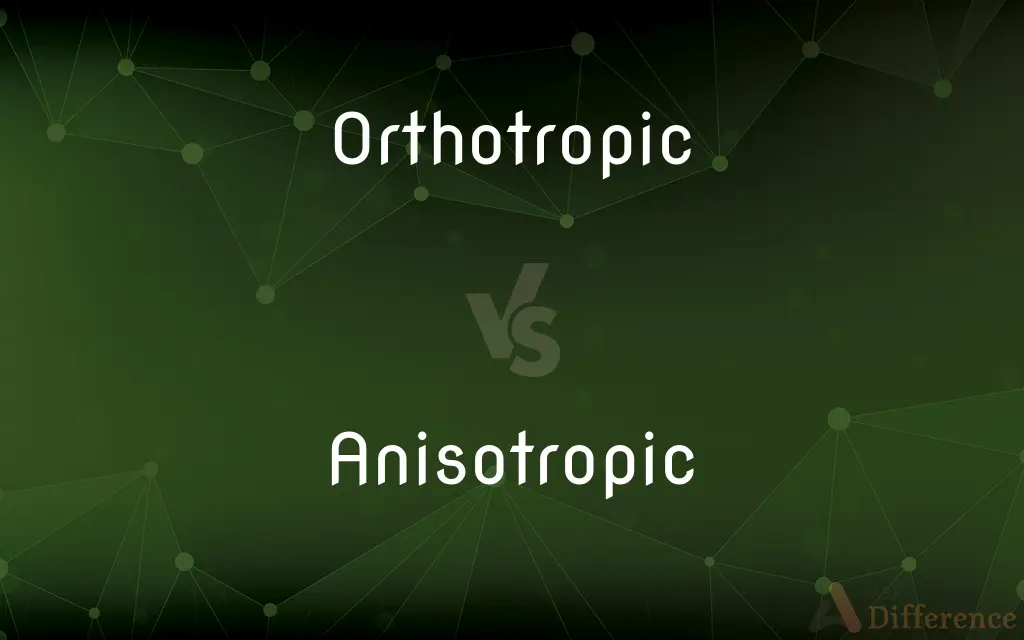Orthotropic vs. Anisotropic — What's the Difference?
Edited by Tayyaba Rehman — By Fiza Rafique — Updated on October 13, 2023
Orthotropic materials have unique properties in three orthogonal directions, while anisotropic materials have direction-dependent properties without the three-direction constraint.

Difference Between Orthotropic and Anisotropic
Table of Contents
ADVERTISEMENT
Key Differences
Orthotropic and anisotropic are terms used to describe the varied properties of materials based on direction. Orthotropic materials have specific and different mechanical or physical properties in three mutually orthogonal directions. This means that if you were to measure properties like strength or conductivity in these three directions, you'd get distinct values for each. A classic example of an orthotropic material is wood, which has different properties along its length, width, and depth.
Anisotropic, on the other hand, is a broader term. It describes materials that have direction-dependent properties, but without the specific three-direction constraint of orthotropic materials. Essentially, if a material does not exhibit the same properties in all directions, it is anisotropic. This can be seen in many crystals or minerals where properties like conductivity or refractive index change based on the direction of measurement.
Both orthotropic and anisotropic contrast with isotropic materials, which have the same properties in all directions. While orthotropic is a subset of anisotropic — meaning all orthotropic materials are anisotropic, but not all anisotropic materials are orthotropic — the distinction is important, especially in fields like engineering or material science.
To put it in perspective, imagine checking the strength of a material. In an orthotropic material, you'd expect three different values along three orthogonal axes. In a general anisotropic material, properties might vary in more complex patterns, not limited to three distinct directions.
Comparison Chart
Definition
Properties vary in three orthogonal directions.
Properties vary depending on direction, not limited to three.
ADVERTISEMENT
Specificity
More specific
Broader term
Example Material
Wood
Many crystals
Relation to Isotropic
Subset of anisotropic
Opposite of isotropic
Fields of Importance
Engineering, material science, especially where orientation matters.
Geology, physics, material science
Compare with Definitions
Orthotropic
Material behavior differing along three axes.
The orthotropic nature of some composites helps in specific applications.
Anisotropic
Not having the same properties in all directions.
Minerals can be anisotropic, with varied conductivity.
Orthotropic
Having distinct properties in three orthogonal directions.
Wood is orthotropic due to its grain structure.
Anisotropic
Directionally dependent without specific constraints.
The anisotropic behavior of some materials is vital in electronics.
Orthotropic
Not isotropic but limited to three varied directions.
An orthotropic material isn't consistent in all directions but is limited to three distinctions.
Anisotropic
Not uniform across all directions.
The anisotropic nature of certain metals affects their machining.
Orthotropic
Exhibiting three different values in three directions.
The orthotropic properties of a material can influence its use in construction.
Anisotropic
Exhibiting varied behavior based on direction.
Anisotropic materials can behave differently when stress is applied from different angles.
Orthotropic
Directionally dependent in three specific ways.
The orthotropic nature of plywood makes it strong in certain orientations.
Anisotropic
Unlike isotropic, properties change with direction.
Anisotropic crystals have unique applications in optics.
Orthotropic
Growing toward or away from a stimulus such as gravity, especially along a vertical axis. Used of a plant or plant part.
Anisotropic
Not isotropic.
Orthotropic
Of or relating to a bridge deck consisting of steel plates supported by ribs underneath.
Anisotropic
(Physics) Having properties that differ based on the direction of measurement.
Orthotropic
(botany) Growing vertically, either upwards or downwards.
Anisotropic
Having properties that differ according to the direction of measurement; exhibiting anisotropy.
The crystal has an anisotropic structure, as it is stronger along its length than laterally.
Orthotropic
(engineering) Having material properties that differ along three mutually orthogonal twofold axes of rotational symmetry.
Anisotropic
Not invariant with respect to direction;
Anisotropic crystals
Orthotropic
Having the longer axis vertical; - said of erect stems.
Common Curiosities
How is anisotropic different from orthotropic?
Anisotropic materials have direction-dependent properties, not limited to just three orthogonal directions like orthotropic materials.
Are most metals orthotropic or anisotropic?
Many metals are isotropic, but some can exhibit anisotropic behavior due to processing or structure.
What defines an orthotropic material?
Orthotropic materials have distinct properties in three orthogonal directions.
Is wood an example of an orthotropic material?
Yes, wood's properties vary along its length, width, and depth, making it orthotropic.
Can a material be both isotropic and anisotropic?
No, isotropic means the same properties in all directions, while anisotropic means varied properties.
Why is understanding these terms important in engineering?
It's crucial to know material behavior in different directions for design, safety, and efficiency purposes.
Which is more common: orthotropic or anisotropic materials?
Anisotropic is broader and thus more common, encompassing various materials including the orthotropic ones.
In how many directions do orthotropic materials vary?
Orthotropic materials vary in three mutually orthogonal directions.
How do engineers account for orthotropic behavior in design?
They use specialized mathematical models and tests to understand and predict material behavior.
Are all orthotropic materials anisotropic?
Yes, all orthotropic materials are a subset of anisotropic materials.
Are crystals typically orthotropic or anisotropic?
Many crystals are anisotropic, with properties that vary in complex patterns.
Which term is more general: orthotropic or anisotropic?
Anisotropic is the more general term, encompassing any material with direction-dependent properties.
Can a material's anisotropy affect its practical applications?
Yes, a material's direction-dependent properties can influence its use in various fields.
Do orthotropic materials always have three distinct property values?
Yes, they exhibit three different property values along three orthogonal directions.
Can a material transition from isotropic to anisotropic?
Yes, processes like deformation or alignment can make a previously isotropic material become anisotropic.
Share Your Discovery

Previous Comparison
Cavalry vs. Infantry
Next Comparison
Controller vs. ComptrollerAuthor Spotlight
Written by
Fiza RafiqueFiza Rafique is a skilled content writer at AskDifference.com, where she meticulously refines and enhances written pieces. Drawing from her vast editorial expertise, Fiza ensures clarity, accuracy, and precision in every article. Passionate about language, she continually seeks to elevate the quality of content for readers worldwide.
Edited by
Tayyaba RehmanTayyaba Rehman is a distinguished writer, currently serving as a primary contributor to askdifference.com. As a researcher in semantics and etymology, Tayyaba's passion for the complexity of languages and their distinctions has found a perfect home on the platform. Tayyaba delves into the intricacies of language, distinguishing between commonly confused words and phrases, thereby providing clarity for readers worldwide.
















































